
19 Dec Here Are 15 of the Most Surprising Archeological Finds in 2024
Source Credit: Content and images from Artnet News. Read the original article - https://news.artnet.com/art-world/2024-biggest-archeological-discoveries-2574244
Archaeology had a massive 2024. Discoveries abounded—from ever-multiplying Pompeii frescos to dinosaur fossils in Iowa—as ancient histories continued to be rethought, fought over, and, in some cases, debunked. Below, we bring you the year’s 15 biggest archaeological finds, from the sewers of Rome to the deserts of Peru.
A Stone Wall Submerged in the Baltic Sea Could Be Europe’s Oldest Megastructure
By Tim Brinkhof, February 21, 2024

3D model of a section of the Blinkerwall adjacent to the large boulder at the western end of the wall. The model was created using Agisoft Metashape by J. Auer, LAKD M-V. Photo: Philipp Hoy, Rostock University. https://doi.org/10.1073/pnas.2312008121
“After traces of the subsequently named ‘Blinkerwall’ showed up in high-resolution hydroacoustic imaging, a team of human divers went in for a closer look. Resting at more than 68 feet beneath the water’s surface, the wall turned out to consist of about 1,400 small stones connecting 300 large boulders.”
Another Roman Dodecahedron Has Been Found, Flummoxing Experts
By Tim Brinkhof, February 23, 2024
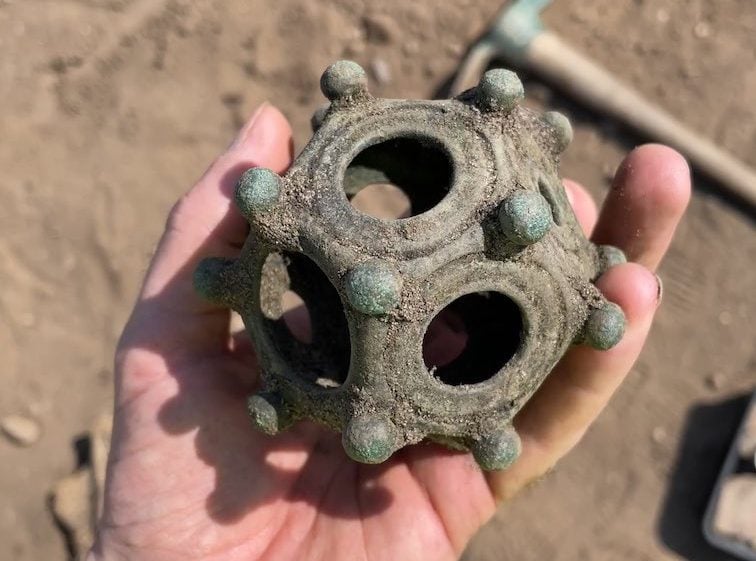
The latest dodecahedron found in Lincolnshire, the U.K. Photo: Norton Disney and Archaeology Group on Twitter.
“Because there are no surviving visual or textual references to dodecahedra, archeologists can do little except speculate. Some believe that the objects may have functioned as measuring devices or calendars, while others think they were used as weapons or tools, possibly for knitting.”
Remnants of a Legendary Typeface Have Been Rescued From the River Thames
By Holly Black, May 5, 2024

Doves Type recovered by Robert Green, 2014. Photography Matthew Williams Ellis
“Green managed to recover a total of 151 sorts (the name for individual pieces of type) out of a possible 500,000. ‘It’s a tiny fraction, but when I was down by the river on my own, for one second it all felt very cosmic,’ he said. ‘It was like Cobden-Sanderson had dropped the type from the bridge and straight into my hands. Time just collapsed.’”
Has the Final Resting Place of the First Roman Emperor Finally Been Found?
By Vittoria Benzine, May 9, 2024

Cross section of the soil layer inside the kiln. Photo: © 2024 IAGS (Mediterranean), University of Tokyo, Komaba.
“Alongside their quantitative data on the new site buried just beneath, researchers observed remnants of a furnace likely used to heat a private bath—precisely the kind of amenity Augustus would have had. Carbon dating on matter left in the furnace showed it hadn’t been used since the era of Augustus’s death. The team also found a warehouse lined with shelves of ceramic amphora vessels, corroborating the temple function Augustus’s villa later served.”
Archaeologists Discover a Mysterious Hidden Structure Near the Giza Pyramids
By Holly Black, May 10, 2024

Survey area, looking south from mastaba G4000. The red rectangle shows the approximate location of the initial survey area. Photo: © Higashi Nippon International University.
“They can already confirm that the structure is around 10 meters by 15 meters, at a depth of 0.5 to 2 meters, and is filled with ‘homogenous sand,’ suggesting it was filled in after its construction. Another anomaly has been found at a greater depth, which could indicate a tomb entrance leading to another chamber.”
Overlooked Hieroglyphics Reveal This Stone Slab Was Part of Ramses II’s Sarcophagus
By Artnet News, June 6, 2024

The long side of the granite sarcophagus identified as that of Ramses II. Photo: © Kevin Cahail.
“The latest discovery, the researchers added, offers further proof that the Valley of the Kings was not just subject to repeated looting, but that its funerary relics were often reused. For example, the tomb of Merenptah, who succeeded Ramses II, was similarly robbed, with one of the sarcophagi recycled by Psusennes I for his own sumptuous tomb.”
A Marble God Is Found in an Ancient Roman Sewer
By Jo Lawson-Tancred, July 9, 2024

Head of marble statue of the Greek god Hermes discovered in sewer at ancient town of Heraclea Sintica. Photo: Archaeologica Bulgarica.
“How did this artistic treasure end up in a sewer? The archaeologists believe it must have been put there for safekeeping some time after 388 C.E., when the city’s infrastructure was devastated by an earthquake and the sewer became disused.”
Construction Workers in Rome Discover Emperor Caligula’s Garden
By Richard Whiddington, July 11, 2024

Lead pipe marked with the Emperor’s name. Phot: Italian Ministry of Culture/Fabio Caricchia
“The connection with Caligula, the first-century tyrant with a reputation for eccentricity and capriciousness, is offered through a lead water pipe stamped with the emperor’s full name: Gaius Caesar Augustus Germanicus. (His nickname means ‘little boot’ and was bestowed for the miniature military footwear his father dressed him up in as a tyke.)”
Ancient Babylonian Tablets Are Finally Deciphered. They’re Full of Bad News
By Richard Whiddington, August 9, 2024
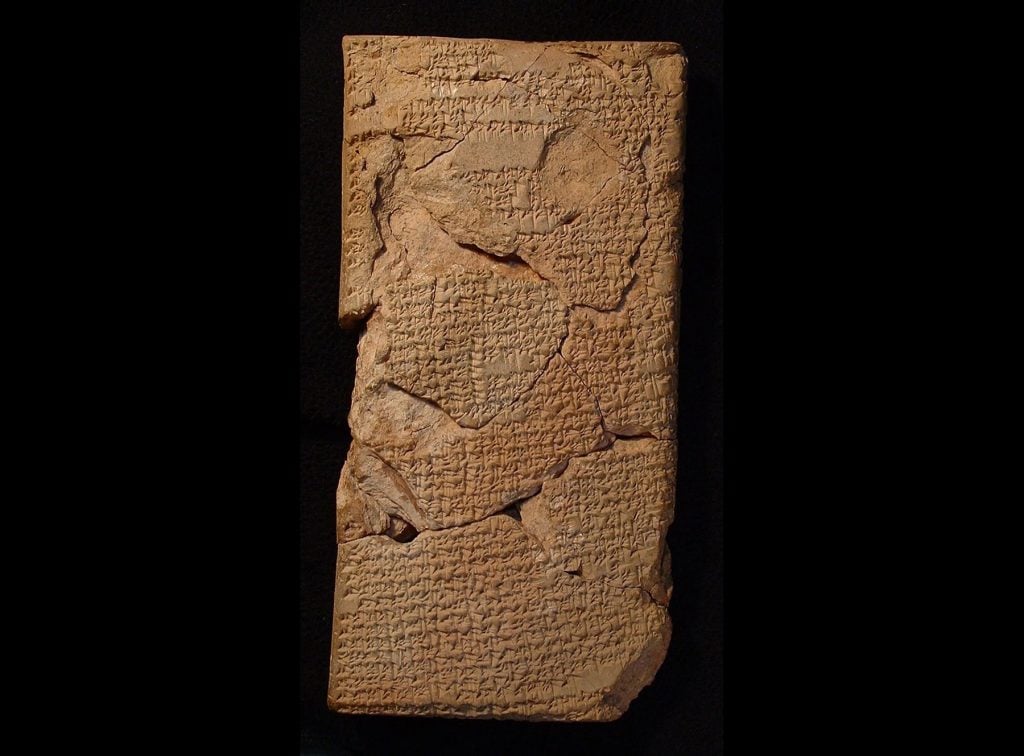
Original tablet as translated in the recent study. Photo: courtesy the British Museum.
“The futures foretold were almost uniformly bad news for the empire, though some signaled destruction for Babylon’s enemies. They range from inclement weather, with the warning ‘the deluge will occur everywhere’; to famine, as in ‘people will trade their children for silver, there will be a reduction in population’; to general chaos, cautioning ‘there will be evil in the land, its bounty will disappear.’”
Ancient Peruvian Site Yields First-Ever Throne Room of a Female Ruler
By Richard Whiddington, September 30, 2024
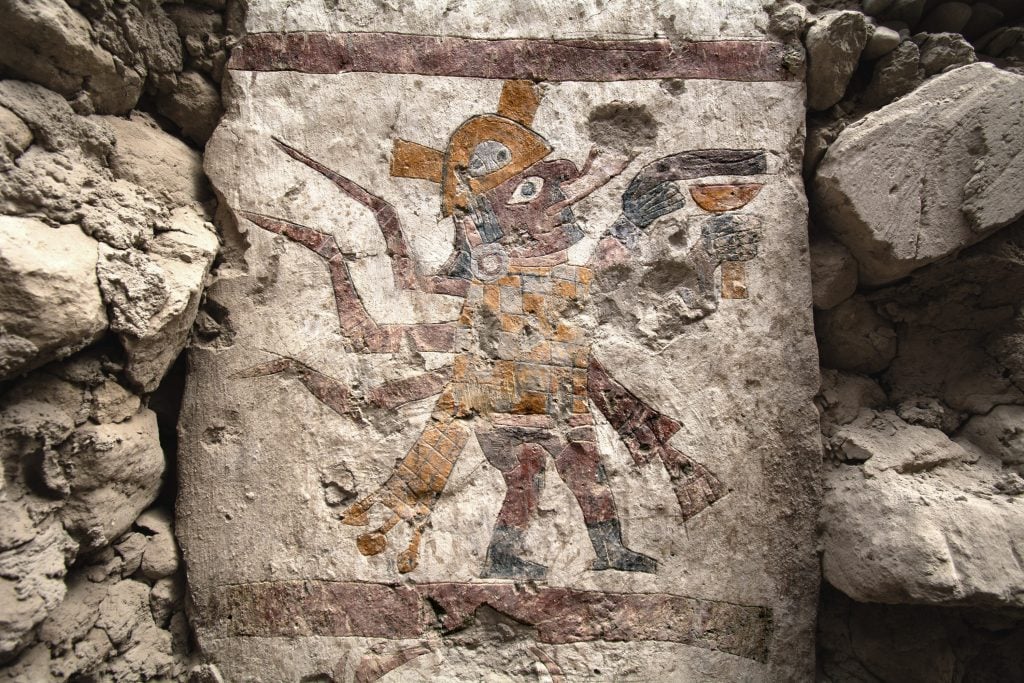
Moche figure with human body and spider features carrying a goblet, painted on a pillar within the Hall of the Moche Imaginary. Photo: courtesy Lisa Trever
“The throne, which is built from painted adobe, directly faces the Pacific Ocean and stands in a room of walls and pillars marked with four scenes depicting a powerful woman. Researchers have named it the Hall of the Moche Imaginary on account of the fantastical painted vignettes that shed light on Moche beliefs and practices.”
Researchers Use A.I. to Identify Hundreds of Mysterious Ancient Geoglyphs in Peru
By Tim Brinkhof, October 7, 2024

Some newly discovered geoglyphs. Photo: Sakai et al. / PNAS.
“With this tool, the researchers were able to discover 303 new figurative geoglyphs, doubling the number of known megaliths in the region. They report, in their study published in the Proceedings of the National Academy of Sciences (PNAS) in September 2024, that most of the geoglyphs depict humanoid figured, decapitated heads, and domesticated animals like llamas.”
2,000-Year-Old Tomb Found Beneath ‘Indiana Jones’ Filming Location in Petra
By Verity Babbs, October 16, 2024
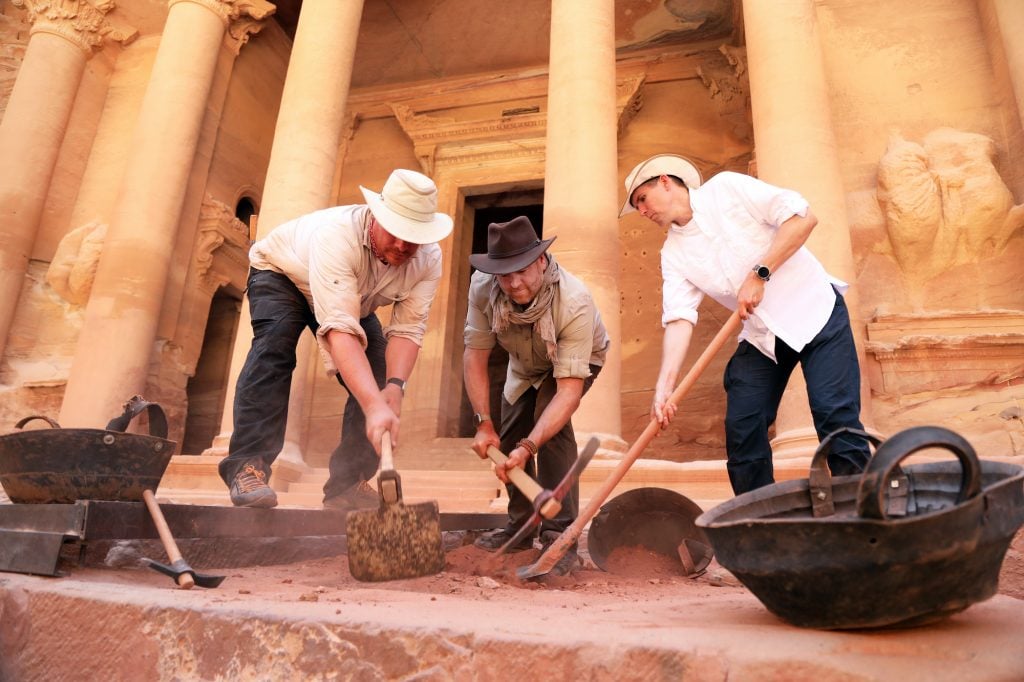
Explorer Josh Gates and Professor Pearce Paul Creasman with archaeologist Matthew Vincent digging in front of the Treasury at Petra. Photo Credit: Discovery’s Expedition Unknown
“The discovery of the tomb is being considered a breakthrough for research into the Nabataean nomadic culture, especially into their mysterious burial practices. Due to a lack of knowledge around these ancient customs, researchers are not sure which members of Nabataean society might have been buried in such a tomb.”
An Extravagantly Decorated ‘Tiny House’ Has Been Discovered in Pompeii
By Verity Babbs, October 24, 2024
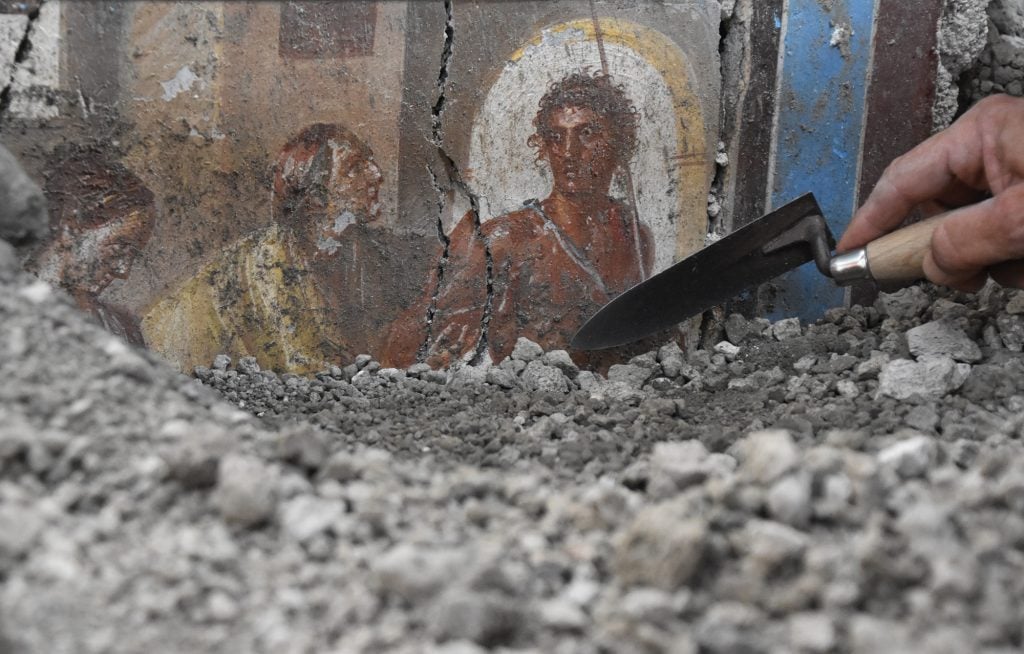
A half-excavated fresco in the central region of Pompeii (2024). Image courtesy of Archaeological Park of Pompeii.
“One small home found to contain frescos which rivaled even its most wealthy neighbors is being provisionally named the House of Phaedra after an excellently-preserved fresco showing a scene from the ancient myth of Hippolytus and Phaedra. Other scenes painted onto the walls of the rear part of the House of Phaedra include an embrace between a nymph and a satyr, a couple thought to be Venus and Adonis, and a damaged mural showing the Judgement of Paris.”
First Dinosaur Fossils Unearthed in Hong Kong Make Their Museum Debut
By Tim Brinkhof, October 25, 2024
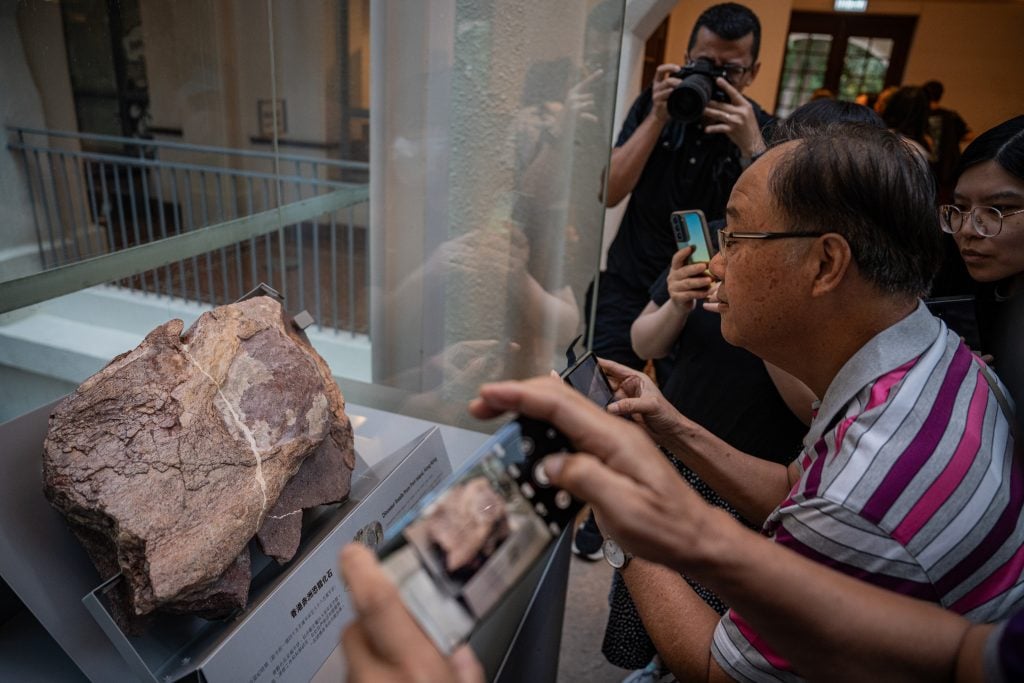
The fossils on display at the Hong Kong Heritage Discovery Center. Photo: Man Hei Leung/Anadolu via Getty Images.
“A first for Hong Kong, which has long been a center of paleontological research but had yet to witness a discovery on its own turf, the fossils have been put on display at the Hong Kong Heritage Discovery Centre in Tsim Sha Tsui, one of the city’s largest and busiest shopping districts, soon to be joined by a workshop where visitors can learn how fossils are preserved and studied.”
New DNA Testing of Pompeii Victims Just Shattered Long-Held Beliefs
By Vittoria Benzine, November 8, 2024
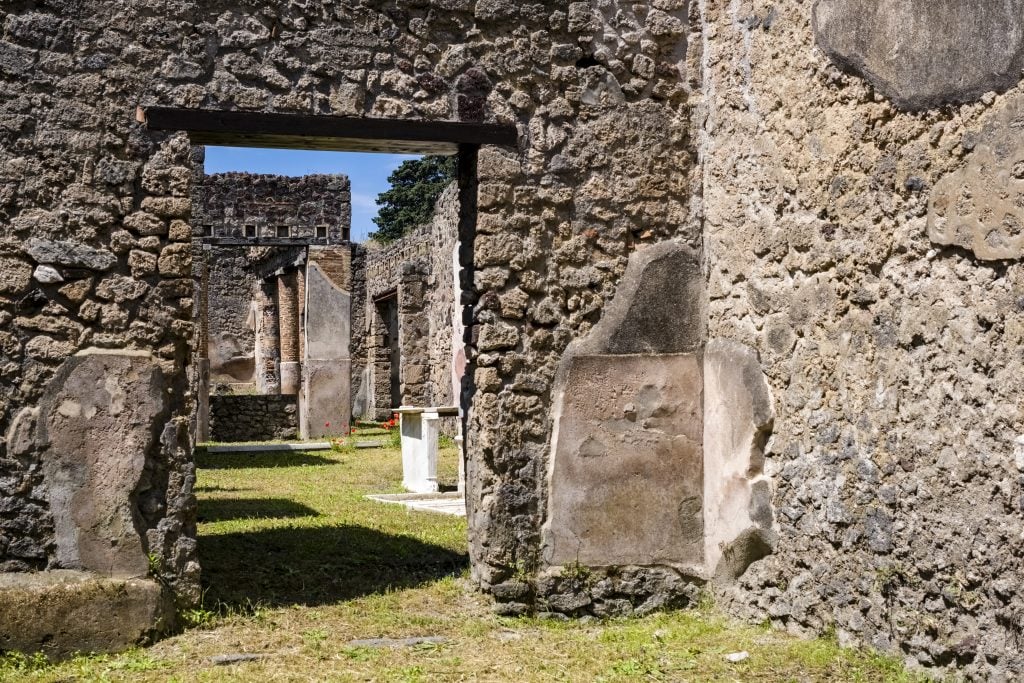
Ruins in Via del Vesuvio in the archaeological site of Pompeii. Photo: Frank Bienewald / LightRocket via Getty Images.
“The paper noted that these revelations show ‘how modern assumptions about gendered behaviors may not be reliable lenses through which to view data from the past.’”
Source Credit: Content and images from Artnet News. Read the original article - https://news.artnet.com/art-world/2024-biggest-archeological-discoveries-2574244

